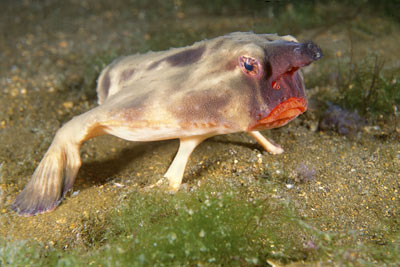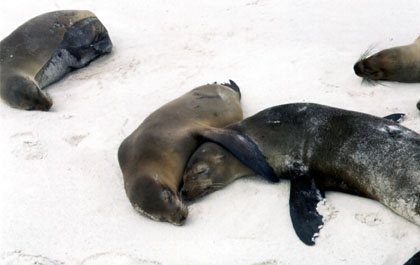Our Galapagos adventure will be one trip that Dave and I will not easily forget! (The total trip was 8 days long for Dave, 13 days for me as I arrived early to take in as much extra scuba diving time as possible.)
DIVING IN THE GALAPAGOS
My first dive blew me away (not literally - thank god!). I saw a massive school of more than 30 white tip and galapagos sharks no more than 5 meters away on my first dive! On the first dive, at Enderby Island (near Floreana Island), the current was very light... however, the currents became stronger during my subsequent dives in North Seymour and then Gordon Rocks (both near Santa Cruz Islands). While I saw my first marble ray resting in an underwater caverne, concentric puffer fish, bright aquamarine slugs and moray eel during those two later dives, the visibility was much worse (5 meters) and at certain points we had to hold on to the rocks to prevent myself from being tossed away from the diving group! Still... it was a great experience in learning to dive with the currents.
After joining the cruise, I had a more opportunities to dive at the further reaching islands. We had signed up with a ship that specifically had a dive master and the equipment on board. This worked out very well as I completed 3 more dives during the cruise: Rabida Island (Near Santiago Island), Espaņola Island, and the Devil's Crown (near Floreana Island). The dives were fantastic... we saw a huge albino stingray (a very rare sight), a pregnant male seahorse (never thought they would be as big as 1/2 a foot long!), a green turtle, marble and eagle rays, moray eels, all types of puffer fish, and massive schools of colourful fish.
But my all-time favourite dive was a private night dive near Espaņola Island (my first night dive!), where I went with William, the boat's dive master on a mission to find the famously ugly and eccentric nocturnal Batfish (see picture below. These nocturnal fish have a crooked nose -- yes fish with noses! --, bright red lips, as well as arms(!!) with fins at the ends. And they walk on the bottom of the sandy floor like a penguin walks on land!). The dive worked out very nicely; we went in the water from a dhinghy boat just after the sun had set (so we still had some light) and once we were about 25 meters deep, a few minutes after the dive, we noticed it was dark. William and I both used underwater flashlights, so if we had to get each other's attention, we just had to wiggle our flashlights around randomly or at something and then used the scuba hand signal to identify the fish.
We found tons of batfish (all solitary though), along with 3 octopus, 2 diamond back stingrays, tiny shrimp, a garden eel, an ornate fireworm (looked like an underwater centipede/caterpillar), sea lions, a lobster, and green glowing phosphorescence. For the latter, all we had to do was turn off our lights and then move our hands around and little bright green dots would appear in front of our faces! It was magical!
Part III - Ecuador -- Galapagos Islands
At first, I couldn't believe how far the Galapagos Islands are from mainland Ecuador. I kept thinking "we're about to land, we're about to land!" but no... over 1000 km later (from a stopover in Guayaquil on the coast), we landed! Maybe it is just my anticipation!
Swimming with Sharks, Ecuatorial Penguins, and Exciting Diving Adventures
As a new diver, barely wet behind the ears, I was a little nervous and apprehensive about diving in the Galapagos. I had only 6 freshwater dives under my belt and I had heard that the Galapagos dives tend to be advanced due to their strong currents. So being the determined and non-risk averse gal that I am, I signed up for three days of diving with the highly recommended Scuba Iguana group (2 dives per day and $110 per day).


Now the diving was the highlight of the trip for me, but let me assure you that the trip was just as much fun above water as it was underwater... with just as much variety in landscape and life forms!
DISCOVERING THE ISLANDS ON WALKING TOURS
During our eight day trip, we visited 10 Islands on the western side of the Galapagos region. Each island had its own special charms with significant variation in both landscape and wildlife.
The following was our 8 day cruise boat itinerary:
Santa Cruz --> Rabida --> Bartolome --> Genovesa --> North Seymour --> Baltra --> Plaza --> Santa Fe --> Espanola --> Floreana --> Santa Cruz

In terms of landscape, we often went from white-fine sandy beaches, to horrific grey leafless trees on a rocky unabiding land (which seemed to belong more on the set of a halloween play than on an enchanted island!), to a gritty red sandy beach, to flamingo lagoons with pitch black bumblebees, to an orange lunar desert-like landscape with volcanic craters and almost no vegetation or lifeforms.
During the walks we fell in love with the cute sea lions (and if we were lucky fur seals at times), we chuckled at the mating calls and rituals of the blue footed boobies and the albatross, we watched in awe at the aggressiveness of the carnivorous mockingbird, and we became all very impressed with the skills of the marine iguanas (eating underwater for up to an hour without air) and land iguanas (eating prickly cactus)!

Strange landscapes, the vegetation and our cruise boat (57 pictures) |

Fascinating marine and land animal life that habitate the islands (98 pictures) |
We wish you a great week and a happy Solstice on June 21! (which is a really big party here, that and the equinox!)
Ciao,
Natia